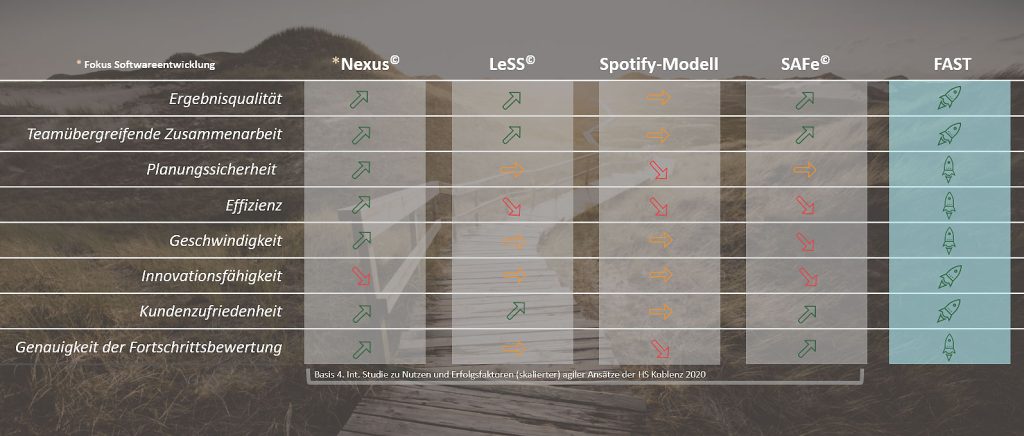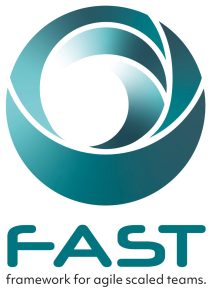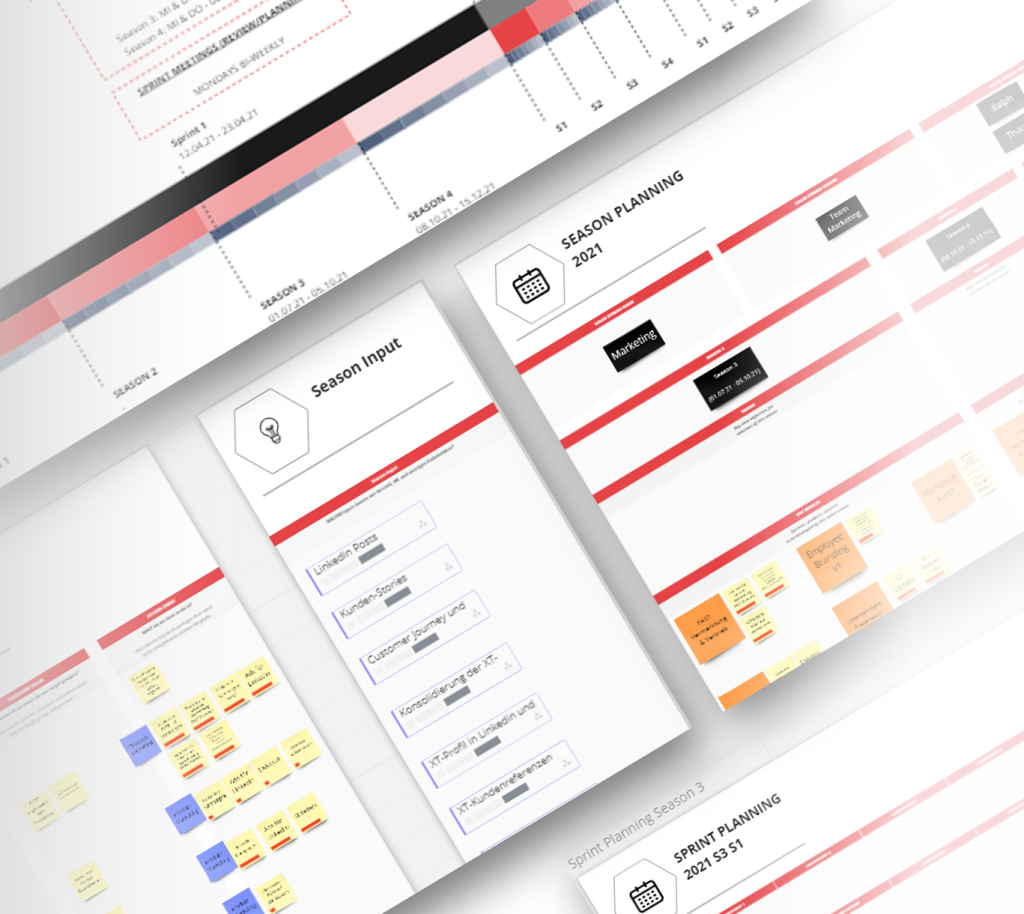Welche agile Projektmethode ist die beste für Ihr Unternehmen? Statt einer pauschalen Antwort lohnt sich ein Vergleich, denn sowohl das Projekt als auch das Unternehmen selbst bedingen, welcher Ansatz am besten passt. Lernen Sie das skalierbare agile Framework FAST im Vergleich zu anderen Methoden des agilen Projektmanagements kennen und treffen Sie eine informierte Entscheidung.
Agile Projektmethoden bieten exzellente Möglichkeiten, mit sich wandelnden Anforderungen umzugehen, wertschöpfend zu arbeiten und die Kundenzufriedenheit zu steigern. Jedoch fällt die Theorie bisweilen leichter als die Praxis: Die gängigen Methoden des agilen Projektmanagements (PM) erfordern meist eine radikale Umstellung oder überfordern mit ihrer Komplexität.
In addition, existing agile PM methodologies originate from the American culture and are adapted to the American way of working and thinking. Therefore, there is a need for modern project management methods that are compatible with European values, habits and attitudes and that allow for gradual implementation.
The FAST approach views the implementation of agile project methodologies as a journey of continuous learning, adaptation and optimization. FAST stands for "Framework for Agile Scaled Teams" and offers a lightweight, innovative Agile PM method with high planning reliability and efficiency thanks to Season Planning. Entry into FAST is gradual and adapts to the agile maturity of the company.
Choosing the right agile methods for project management

"FAST is dynamic and innovative, and despite its proximity to SAFe® lightweight, much faster to implement. Certain shortcomings of the established frameworks, such as planning reliability and efficiency, are precisely the strengths of FAST".
Tobias Lenschen, Senior Consultant and FAST Expert at Xtentio
There is no one-size-fits-all approach to agile management. Your choice will depend on a number of factors, including
- the company's environment (e.g. with regard to compliance),
- of the technical infrastructure,
- the type of products to be developed,
- the market environment (saturated vs. innovative) and
- How familiar the organization is with agile project methods.

Koblenz University of Applied Sciences conducts an annual international study on "Benefits and Success Factors of (Scaled) Agile Approaches". The 2020 evaluation found that about two-thirds of respondents were not using agile project management methods in their organizations. The main reasons cited were lack of expertise, just starting to roll out at the team level, more long-term planning, and lack of demand. Concerns that the rollout would overwhelm managers were also raised.
Unter dem Drittel der Befragten, die bereits agile Zusammenarbeitsmodelle nutzten, gab wiederum ein Drittel an, keines der bestehenden Modelle, sondern eine Eigenentwicklung zu nutzen. Die Auswertung der Studie zeigt also, dass Bedarf an einfach zu etablierenden Methoden besteht, die sich an die individuellen Anforderungen moderner Unternehmen anpassen. Die FAST-Methode kombiniert die flexiblen, dynamischen Ansätze anderer skalierbarer Methoden auf leichtgewichtige Weise mit Planungssicherheit und Effizienz.
The comparison between FAST and other approaches makes it easier for you to choose the right agile project method for your company.
This is how FAST differs from other agile project methods
The classic waterfall model is associated with a high degree of planning reliability: the successive phases of the project are precisely defined from the outset so that the desired result is reliably achieved. The downside is that, unlike agile project management, the waterfall model leaves little room for change and coordination with the customer. In addition, the result is not presented until the very end of the work, whereas agile PM methods deliver partial results at short intervals.
FAST FAST embraces the strengths of the waterfall method, particularly its ability to provide predictability through measurable progress. On the other hand, companies can use FAST, similar to Scrum project management,
- much easier to adapt to changing requirements,
- incorporate customer feedback and
- Flexibly control time and budget.
The limitations of the Scrum methodology and some possible solutions
Agile project management with Scrum reaches its limits as soon as a project exceeds the capacity of the Scrum team. The Scrum of Scrums (SOS) method was born out of the need to form multiple teams, share ideas across teams, create networks, and overcome potential obstacles together.
Simply put, in agile work with Scrum of Scrums, one team member at a time represents his or her Scrum team, so that the representatives have a better overview and can create the necessary interfaces in case of dependencies between teams. However, scalability is still severely limited, so this variant of Scrum project management, unlike FAST, is not suitable for large transformation projects.
The Nexus framework also provides a way to scale the Scrum methodology. Here, up to nine teams are managed by a Nexus integration team. Working across teams with Nexus is efficient and easy to implement. However, the Nexus framework is very product or software development oriented and therefore less suitable for the agile transformation of companies.
The Large-Scale Scrum (LeSS) method also works on a similar principle: Up to eight teams, or even more in the case of LeSS Huge, are coordinated in processes that are kept as simple as possible.

However, neither the agile Nexus model nor LeSS achieves the almost unlimited scalability of frameworks such as SAFe® and FAST. In addition, the implementation of Nexus or LeSS requires quite a radical change, especially for larger (e.g., cross-departmental) projects - which, as the Koblenz study suggests, could lead to excessive demands and resistance.
Thinking big about scalability: SAFe® and FAST

SAFe®, the Scaled Agile Framework, was the answer to the question of how to scale even the largest projects using Scrum-based methods: SAFe® leverages the many benefits of agile and can be used for large transformation projects.
What is the difference between SAFe® and FAST? Especially in its ease of use: FAST takes the fundamental concept of agile Scrum, combines it with the massive scalability of SAFe®, and adds the last piece of the puzzle: a lean, lightweight implementation that makes it possible to get started even in places where the potential of agile project management has not yet been nearly tapped. FAST can therefore accompany an organization in agile development for years. A later move to the more complex SAFe® is not ruled out, once employees are fully familiar with agile project methods in the future.
FAST, the Framework for Agile Scaled Teams,
- creates planning security like the waterfall model,
- like SAFe®, is scalable for the largest projects,
- pursues lean approaches such as Nexus and LeSS, and
- leads to fast, sustainable success.

